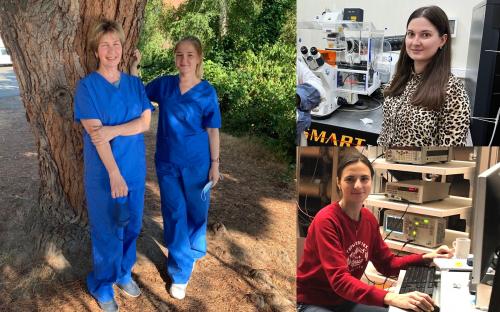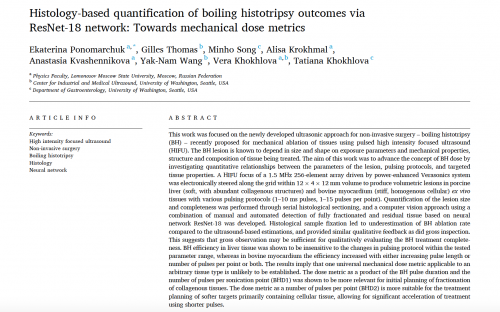The results of our research on the development of a dose concept for boiling histotripsy were published in a top-rated journal Ultrasonics
Our paper titled «Histology-based quantification of boiling histotripsy outcomes via ResNet-18 network: Towards mechanical dose metrics» has been published in a top-rated journal Ultrasonics (Q1, IF 4.2) by LIMU research fellows, graduate students, and alumni: E.M. Ponomarchuk, A.A. Krokhmal, A.V. Kvashennikova, and V.A. Khokhlova.
The paper presents the results of our research study aimed at development of a threshold exposure dose for effective mechanical fractionation of unwanted tissues using boiling histotripsy. The difficulty in developing a concept of mechanical dose lies in different response of tissues to mechanical fractionation, as opposed to, for instance, their similar sensitivity to thermal necrosis, which underlies thermal HIFU surgery and, accordingly, the concept of thermal dose.
In the study, volumetric mechanical lesions were experimentally produced in soft tissues of different structure and composition under varying protocols of ultrasound exposure. The quality of each resulting lesion, depending on the exposure protocol, was analyzed quantitatively via histological analysis. In order to automate the analysis of histological images, a neural network algorithm based on ResNet-18 was developed in this work.
It was shown that pre-treatment planning of tissues different in composition should be based on different dose concepts. Specifically, to fully fractionate tissues high in collagen, certain threshold value of the product of the pulse duration and the number of pulses per each sonication point should be exceeded (given the tissue boiling is induced within each pulse). If a primary target tissue is mostly cellular (i.e., low in collagen), the treatment could be planned based on the threshold number of pulses per sonication point, nearly regardless of the pulse duration. This allows the use of shorter pulses to significantly increase the ablation rate in tissues low in collagen.
Overall, the published study proposes the concept of a threshold dose for tissues with high and low collagen content, which can be used for preliminary planning of non-invasive mechanical fractionation of tissues different in structure and composition using boiling histotripsy.
The work was supported by grants from the Russian Science Foundation, Focused Ultrasound Foundation, as well as the “BASIS” and “Intellect” foundations.
The full text of the paper can be found here.




